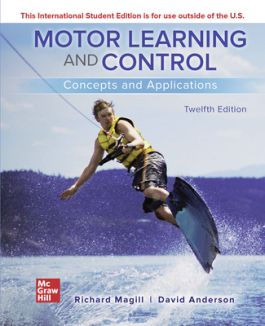Motor Learning and Control ISE
After purchasing your eBook, login to the McGraw Hill Bookshelf website and redeem the access code from your order confirmation email.
- Access your eBook online or offline
- Easily highlight and take notes
- Fully searchable content
- Syncs across platforms
NOTE: eBook purchase does not include Connect homework or adaptive SmartBook assignments
CHAPTER 1: The Classification of Motor Skills
CHAPTER 2: The Measurement of Motor Performance
CHAPTER 3: Motor Abilities
Unit 2 Introduction to Motor Control
CHAPTER 4: Neuromotor Basis for Motor Control
CHAPTER 5: Motor Control Theories
CHAPTER 6: Sensory Components of Motor Control
CHAPTER 7: Performance and Motor Control Characteristics of Functional Skills
CHAPTER 8: Action Preparation
Unit 3 Attention and Memory
CHAPTER 9: Attention as a Limited Capacity Resource
CHAPTER 10: Memory Components, Forgetting, and Strategies
Unit 4 Introduction to Motor Skill Learning
CHAPTER 11: Defining and Assessing Learning
CHAPTER 12: The Stages of Learning
CHAPTER 13: Transfer of Learning
Unit 5 Instruction and Augmented Feedback
CHAPTER 14: Demonstration and Verbal Instructions
CHAPTER 15: Augmented Feedback
Unit 6 Practice Conditions
CHAPTER 16: Practice Variability and Specificity
CHAPTER 17: The Amount and Distribution of Practice
CHAPTER 18: Whole and Part Practice
CHAPTER 19: Mental Practice
Glossary
References
Name Index
Subject Index
Motor Learning and Control: Concepts and Applications is an introduction to the study of motor learning and control for students who aspire to become practitioners in exercise science, physical education, and other movement-oriented professions. Each chapter presents motor learning and control as a set of principles and guidelines based on research evidence. The authors' clear writing style and practical applications will help students build a solid foundation and prepare them for further exploration on their own.
NEW FEATURES:
- Updated and added new research relevant to the concept discussed in each chapter.
- Added section describing and discussing the OPTIMAL theory of motor learning and control, and included a relevant discussion of OPTIMAL theory.
- Added section describing HABIT (Hand-Arm Bimanual Intensive Therapy) strategy to include therapeutic strategies for improving bimanual coordination skills for people with cerebral palsy (CP).
- Added a new section on brain changes in elite athletes.
- Added sub-section "Manual Guidance as Augmented Feedback" to section "Types of Knowledge of Performance."

